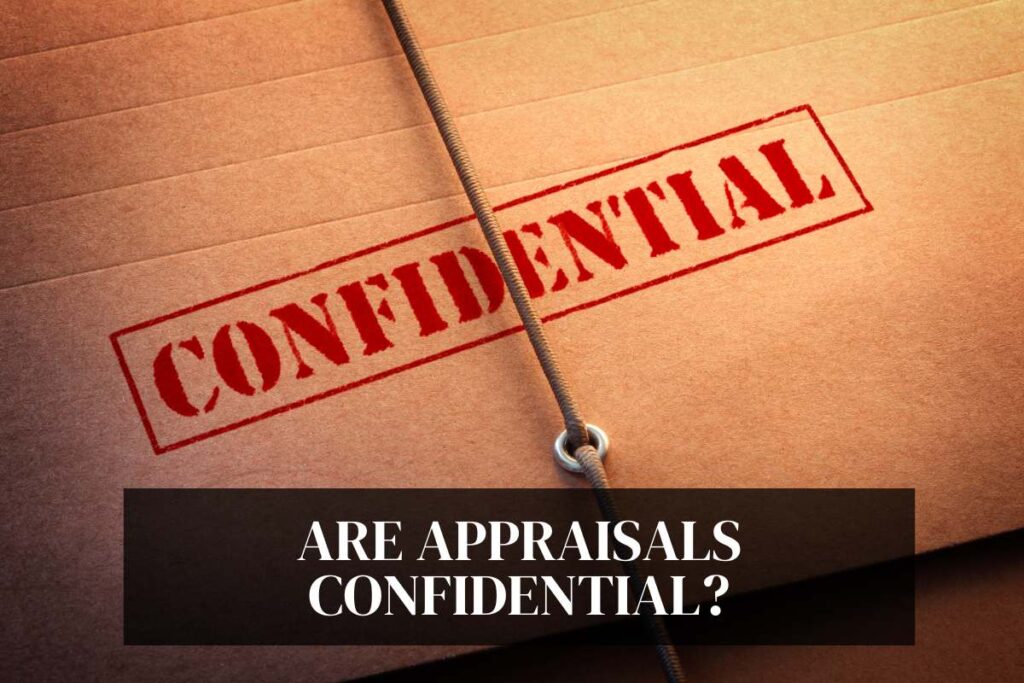Last updated on April 4th, 2024 at 02:48 am
Having an appraiser walk through your home taking photos, notes, and asking questions can seem a bit invasive to some homeowners. Is this something you should worry about?
Are appraisals confidential?
Appraisers must follow specific guidelines when it comes to defining who the “allowed users” of the appraisal report are. This definition dictates to whom the appraiser can release the report and any of its contents.
In simple terms, The Confidentiality Section of the Ethics Rule of USPAP states that an appraiser is not allowed to share private information or the results of your appraisal with anyone other than the client or others specified by the client. This includes photos, documents, drawings, notes, and anything else collected at the time of the appraisal inspection.
Who Is the Client?
Appraisers must treat the party who ordered or assigned the appraisal as “the client”, regardless of who pays the appraisal fee. This is a commonly misunderstood part of the appraisal process.
The client can be a property owner, a lending institution, a government agency, or a legal entity involved in a real estate transaction.
Appraisals are ordered for a specific purpose and a certain “intended user”. How the fee is collected and who is responsible for payment to the appraiser can vary.
RELATED: 10 REAL ESTATE APPRAISAL MYTHS, DEBUNKED
Who Are The Intended Users?
The intended users of an appraisal report include the client who ordered the appraisal and any additional users as identified by the client at the time of the assignment.
For example – a homeowner may request an appraisal to determine a list price for their home.
The homeowner may choose to designate his or her real estate agent as an intended user so that the appraisal can be sent to both parties.
The appraiser must identify the client and any additional intended users within the report.
Once the appraisal inspection and the report are completed, the “client” can share this information with others as they see fit.
Why Are Clients and Intended Users Important?
Proper identification of the client and intended users is an important step in the appraisal process, as this defines the parties that receive and hold rights to the completed report.
To ensure the report meets the lending criteria and conforms with USPAP, appraisers must clearly identify and understand who their clients and intended users are. This is true from the initial acceptance of the assignment until delivery of the report.
Now that we’ve cleared up a few of the appraiser’s responsibilities to the lender, I know what you’re thinking…
“But I paid for the report!”
Fear not – you, as a buyer, are still entitled to a copy of your appraisal report, though you will most likely need to obtain it from the lender.
Are Appraisals Confidential? A Deeper Dive on Confidentiality Rules

The Confidentiality section of the Ethics Rule (which appraisers must adhere to) reads, in part:
An appraiser must not disclose confidential information or assignment results to anyone other than:
- the client
- parties specifically authorized by the client
- state appraiser regulatory agencies
- third parties as may be authorized by due process of law
- a duly authorized professional peer review committee except when such disclosure to a committee would violate applicable law or regulation.
This means that entities like FHA, The Dept of HUD, and appraiser licensing agencies and review boards may be designated to have access to certain information in some cases.
Under these guidelines, confidential information includes “any information the appraiser receives from the client and is identified by the client as confidential and is not available from other sources”.
Furthermore, the Safeguards Rule of the Gramm-Leach-Bliley Act prohibit the transmittal of any appraisal-specific information whether verbal or written to any party other than the intended user(s).
As you can see, this is a heavily regulated part of the appraisal process, and your own appraiser is simply following the rules put in place to protect all parties from the contents of the report being compromised or shared in public.
RELATED: DOES AN APPRAISAL INCREASE MY PROPERTY TAXES?
Photos Taken During the Appraisal Inspection

Some homeowners get downright offended when I inform them that I’ll be taking photos inside their home.
I mean, this is an invasion of privacy, right?
Besides, not only have you already had beautiful photos taken as part of the listing process, but you have a sink full of dishes, the beds aren’t made, and you don’t want those photos out there in the digital world!
All valid arguments.
However, for most mortgage transactions, interior photos of your home will likely be required by the lender as part of the completed appraisal.
Not only is this a standard requirement for most lenders, but it serves a few other important purposes:
1. Support for the property description:
Interior photos lend visual support to identifying the quality and condition of the home as it’s reported in the appraisal.
For example, if the appraiser boosts your value due to an extensive kitchen renovation, the photos included should match this description, ensuring support for the value increase.
2. Support for noted amenities, room counts, etc.:
If the appraisal report notes a significant amount of amenities or features which warrant adjustments when comparing your home to others, the lender wants visual confirmation that these are, in deed, worthy of a significant value contribution.
In addition, lenders want confirmation that there are, in fact, 4 bedrooms and 2 baths if that is what’s stated in the report.
3. It’s helpful to the appraiser:
Most appraisers see several homes each week if not each day. The photos we take assist in allowing us to recall specific details of each home. The distinctive features, layout, and condition captured in the interior photos contribute to a more accurate report.

As they say, a picture is worth a thousand words.
This visual documentation is especially helpful to an appraiser with a busy workload.
4. Appraisal Disputes:
Interior photos play an important role in resolving potential disputes. If there is disagreement over the property value, these images serve as tangible evidence of the home’s condition, amenities, and overall quality.
By referencing interior photos, appraisers can provide concrete support for certain aspects of their valuation, offering transparency and clarity.
5. The Work File:
Appraisers are obligated to maintain a work file of each appraisal for a minimum of five years. Interior photos may play a role in supporting their assessments over time. These visual records serve as enduring evidence of the property’s condition and features.
In the event of a regulatory agency questioning the report years later, these photos provide a reliable record of the property at the time of the appraisal.
Will The Appraiser’s Photos Be Shared With Anyone?
Rest assured, when appraisers take photos inside your home, they are committed to keeping them private.
These pictures may only be shared with the specific client that hired the appraiser – usually your lender. This is a standard practice that safeguards your privacy, ensuring that details about your home remain confidential.
Trust me, putting a photo of your dirty laundry on Facebook is NOT worth losing our license over.
If confidentiality is breached by an appraiser, there can be serious consequences.
Appraisers are bound by ethical and legal obligations to keep the information they gather confidential.
Breaching this rule can result in legal consequences, disciplinary action, possible suspension or revocation of their credentials or license, or other regulatory action.
RELATED: COMMON APPRAISAL QUESTIONS
The Bottom Line
In the digital age, it is undoubtedly a valid concern about your private information being placed in the hands of strangers who come into your home.
However, entrusting appraisers with confidential information is a secure decision due to the stringent guidelines they must adhere to.
(It’s also worth noting that all licensed appraisers must pass a criminal background check before issuance of their license.)
Appraisers are aware of and strictly adhere to these requirements to maintain the trust of their clients, protect themselves legally and professionally, and uphold the integrity of the appraisal profession.
How Can I Obtain A Copy of The Appraisal?
While you may not receive a copy of your appraisal directly from the appraiser, TheEqual Credit Opportunity Act (ECOA) requires creditors to provide a copy of home appraisals and other written valuations on the property after they are completed, “regardless of whether credit is extended, denied, incomplete, or withdrawn”.
If you’re a buyer and you’ve paid for a home appraisal, reaching out to your lender is the best route. They will serve as your primary point of contact throughout the process and should be willing to provide you with this information.
Frequently Asked Questions

Kimberly has been a Certified Appraiser in New York since 2004. With a background in the mortgage industry and prior licensure as a real estate agent, she brings a valuable perspective to buyers, sellers, and other industry professionals. Aside from her professional role, she’s an entrepreneur, novice home flipper, and proud mom of three.
License No. 45000046311 | FHA Certified | Member GSAR/NYSAR | Approved Supervisory Appraiser





